Arkansas boasts an array of flora and fauna, lending its nickname, the Natural State. Along with common animals like deer and coyotes, it’s also home to unique animals like armadillos and bog lemmings. The state is also home to a variety of different spiders. Myriads of spiders live in Arkansas, from ornate orb-weavers to giant tarantulas. Here’s an overview:
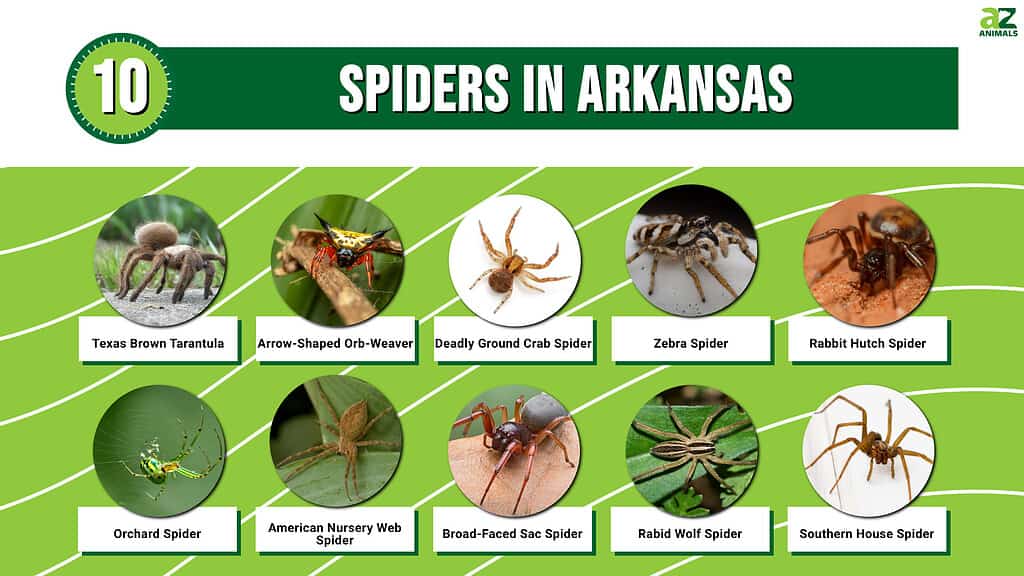
Keep reading to learn about ten different spiders in Arkansas that you could encounter if you live or travel there. All spiders are from the Class Arachnida, but the family tree spreads out widely from that common point; so widely, in fact, that each of the spiders below comes from a different family! We’ll name them for you.
#10: Southern House Spider

Male southern house spiders are often confused for the more poisonous brown recluse.
©Sample Stars/Shutterstock.com
Southern house spiders are very common spiders in Arkansas. They are widely distributed throughout the southern United States, Caribbean, and South America.
Southern house spiders have a leg span of around 5 centimeters, with males and females measuring around the same size. That said, males have longer legs, while females have larger bodies. Males are sometimes confused for brown recluses but lack the distinctive violin-shaped marking. Both specimens are typically brown, with females usually appearing darker than males.
Female southern house spiders build radial-style webs, which they use to catch prey. Their webs are not sticky and are designed to entangle prey long enough for them to comb the strands towards themselves. They rarely bite humans, and their bite is not considered dangerous to humans.
#9: Rabid Wolf Spider

The rabid wolf spider gets its name from its quick, erratic movements.
©Brett Hondow/Shutterstock.com
Rabid wolf spiders are members of the wolf spider family Lycosidae. A native to North America, you can find these spiders in Arkansas and throughout the eastern and southern United States. These spiders get their name from their frantic movements, which make them look as if they’re rabid.
Rabid wolf spiders are predominantly yellow and possess long legs, as is typical with other wolf spiders. Their cephalothorax contains two thin dark brown stripes, while their abdomen features one thick dark stripe. Females measure around 2.5 centimeters long and usually grow to be twice the size of males.
Rabid wolf spiders do not build webs and instead rely on camouflage and agility to catch prey. While their name sounds threatening, they are unlikely to bite people unless backed into a corner. Their bite can be a bit painful but is relatively harmless to humans.
#8: Broad-Faced Sac Spider
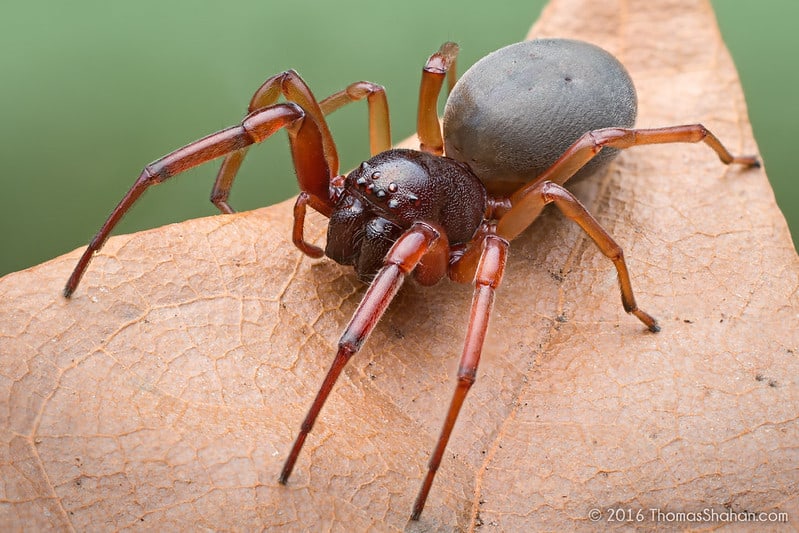
The broad-faced sac spider will willingly scavenge for dead spiders and insects.
©Thomas Shahan / flickr – License
Broad-faced sac spiders belong to the family Trachelidae and are also known as the ground sac spiders. You can find these spiders in Arkansas, although their range extends throughout the eastern United States as far north as Canada. During the day, they hide in silk-lined sacs, which they construct under leaves, stones, or boards on buildings.
Females measure from 7 to 10 millimeters long, and males clock in at 5 to 6 millimeters in length. Their mouthparts and carapace appear reddish-brown, while their abdomen ranges from light grey to yellow.
Unlike most other spiders, broad-faced sac spiders are willing scavengers of dead spiders and insects. Their bite is quite painful and carries a risk of secondary infection. That said, most bites produce symptoms no worse than a bad bee or wasp sting.
#7: American Nursery Web Spider
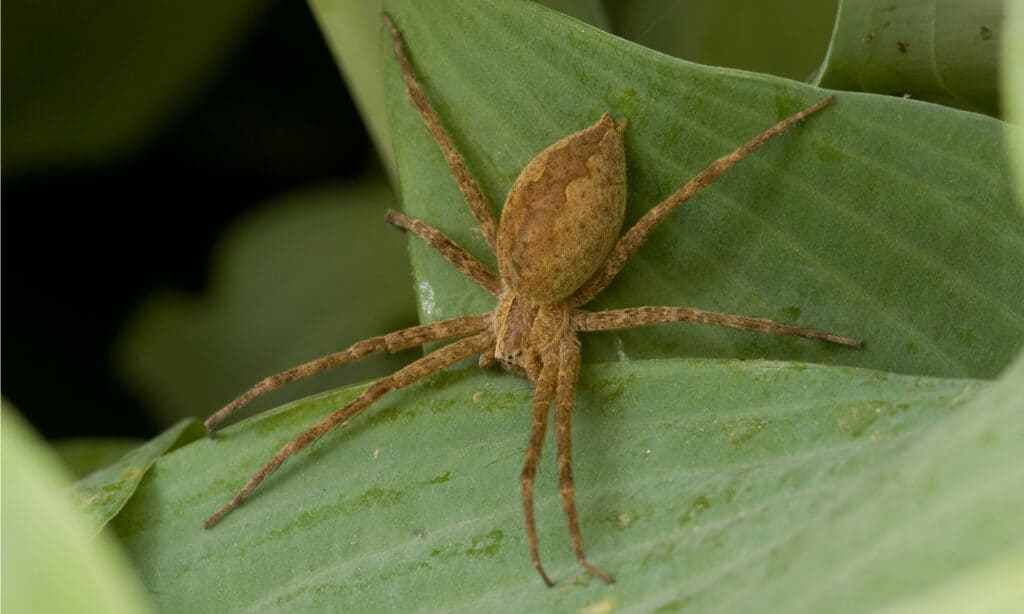
The American nursery web spider only constructs a web when it’s ready to lay its eggs.
©SDeming/Shutterstock.com
American nursery web spiders belong to the family Pisauridae. They are widely distributed throughout the eastern half of North America and are one of the most common spiders in Arkansas. You’re most likely to encounter them in areas with dense weeds or shrubs, which is where they like to construct their webs.
Most specimens are brown, although they can also look tan, and are distinguishable by their very long legs. Females can reach up to 19 millimeters long, with males measuring shorter than females. Since females often cannibalize males after mating, males will frequently bind a female’s legs with thread prior to copulation to avoid being eaten.
As their name suggests, females only build webs when ready to lay eggs. As a result, they are active hunters who typically use ambush tactics to hunt their prey. While they are poisonous, their bite is not dangerous to humans.
#6: Orchard Spider
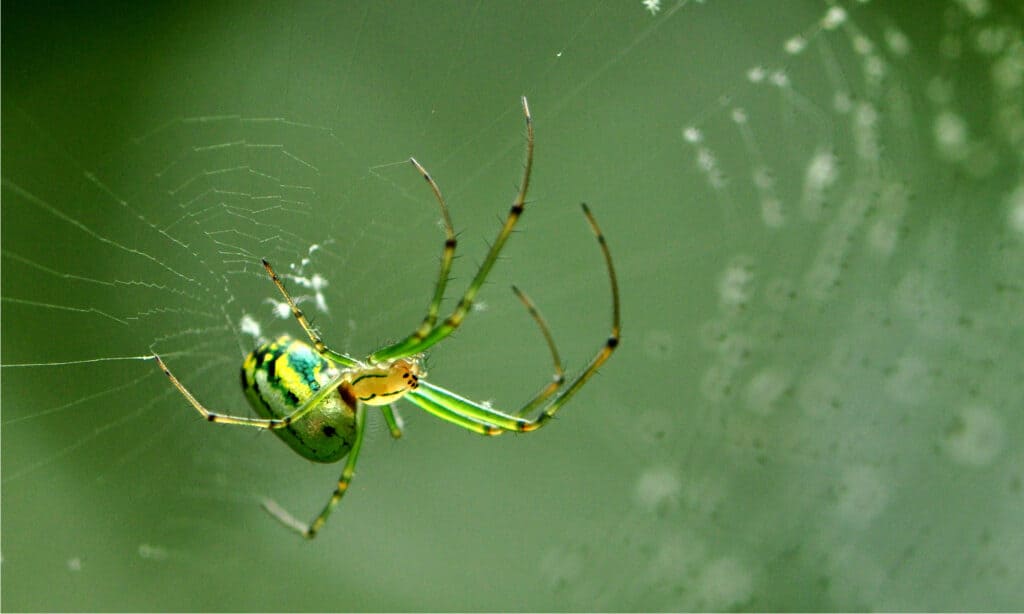
The orchard spider gets its name from its willingness to build its webs in forested areas.
©Shelly Jefferson Morton/Shutterstock.com
Orchard spiders belong to the family Tetragnathidae or the long-jawed orb-weavers. You can find these spiders in Arkansas and through the eastern United States. Their range stretches from Canada in the north to Colombia in the south.
Orchard spiders possess distinctive leaf-green coloration on their legs and sides. Meanwhile, their underside is black and yellow, while their top is silver-streaked with black and brown stripes. Most specimens measure 3.5 to 7.5 millimeters long, with females measuring larger than males.
Like other orb-weavers, orchard spiders hang facing downwards in the center of their web. They build their webs in woodland and forest areas, including man-made habitats like orchards, hence their name. Their bite is not harmful to humans, and they prey on many garden pests, which leads many to consider them beneficial to humans.
#5: Rabbit Hutch Spider
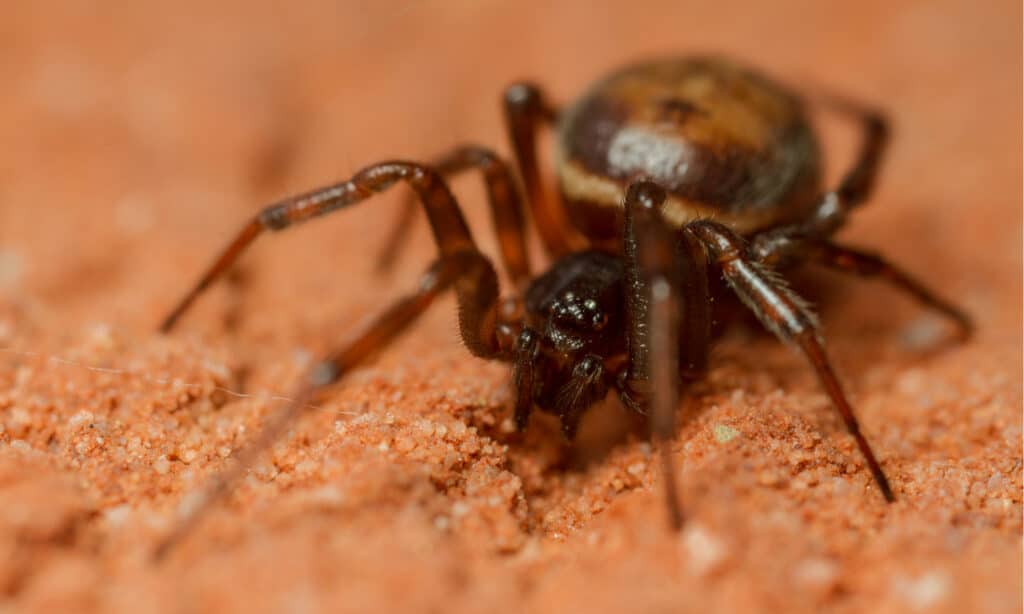
Due to its small size, the bite of a rabbit hutch spider is unlikely to pierce human skin.
©thatmacroguy/Shutterstock.com
A member of the cobweb spider family Theridiidae, Steatoda bipunctata is commonly known as the rabbit hutch spider. It often makes its home in rabbit hutches, sheds, and basements, which is where it gets its name. The rabbit hutch spider belongs to the genus Steatoda, which goes by the name ‘false widows’ due to its similar appearance to black widows.
A small species, most specimens rarely measure larger than 7 millimeters long. They have large, brown abdomens with a pale, whitish line running down the middle and another line across the front. Females typically appear slightly lighter than males and possess a glossy sheen.
Due to their small size, the fangs of a rabbit hutch spider are unlikely to pierce human skin. However, if you are bitten by one, its bite is not likely to be dangerous, as its venom is not particularly potent.
#4. Zebra Spider
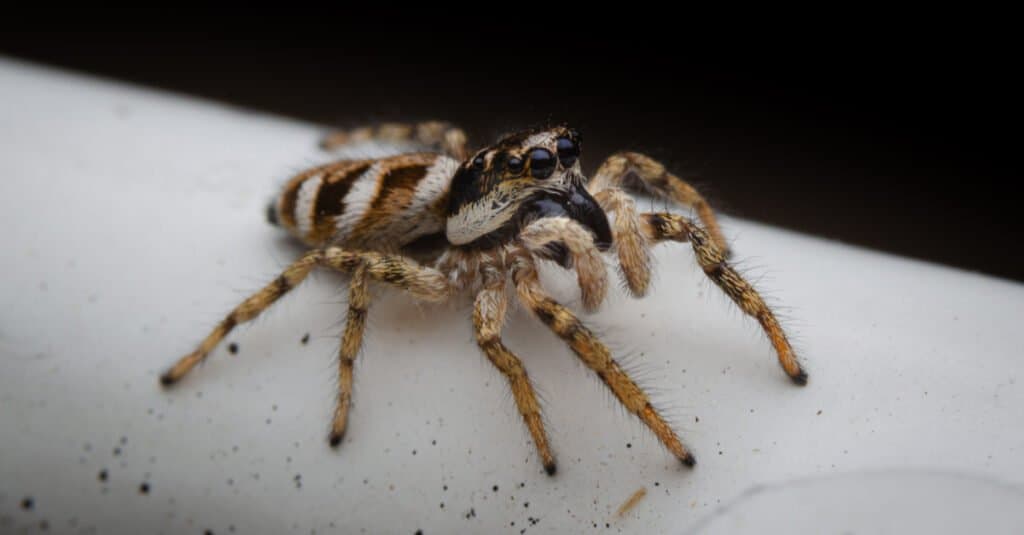
The zebra spider has excellent binocular vision and leaping ability.
©Mario.Pieper/Shutterstock.com
Zebra spiders are one of the most visually striking spiders in Arkansas. You can find these unique-looking spiders throughout the state and the rest of North America and Europe. They tend to live close to urban areas, both inside and outside buildings.
Zebra spiders get their name from their unique black and white stripes, making them look like zebras. A small species, females measure from 5 to 9 millimeters long, while males measure 5 to 6 millimeters.
Like other jumping spiders, zebra spiders do not build webs. Instead, they rely on their keen eyesight and agility to catch prey. They prey mostly on smaller spiders and insects but have been known to target prey nearly three times their size. Before jumping, they attach a silk thread to the ground so they can return to the same spot if they miss.
#3. Deadly Ground Crab Spider

The deadly ground
crab spider
is not nearly as dangerous as its name implies.
©iStock.com/GlobalP
Deadly ground crab spiders belong to the crab spider family Thomisidae. In addition to being common spiders in Arkansas, you can find them throughout much of the United States, Mexico, and Canada.
Female deadly ground crab spiders measure around 10 millimeters long, with the males measuring about half the size of the females. Most specimens are orange with darker mottling on their abdomens. They get their name from their long, curved legs, which lend them a crab-like appearance.
Unlike most spiders, the deadly ground crab spider does not build a web and instead actively hunts for its prey. Despite its fearsome name, the bite from a deadly ground crab spider poses little threat to humans, as its fangs can barely pierce human skin. At worst, its bite causes some pain and swelling that subsides within a few days.
#2: Arrow-Shaped Orb-Weaver

The arrow-shaped orb-weaver gets its name from its distinctive triangle shape.
©Chui Wui Jing/Shutterstock.com
Also known as triangle orb-weavers, arrow-shaped orb-weavers are members of the orb-weaver family Araneidae. You can find these spiders in Arkansas and throughout North America.
Female arrow-shaped orb weavers measure from 7 to 14 millimeters long, while males measure around half that size. They get their name from their distinct abdomen, shaped like an arrowhead. The abdomen varies in color from white to yellow, while the rest of the body and legs are reddish-brown with black markings.
Unlike most orb-weavers, the arrow-shaped orb-weaver sits facing upwards in its web. Its web is made of strong, sticky silk which is designed to entangle and capture prey. Once an insect gets entangled in its web, the spider will reel in its prey by pulling threads towards itself.
#1. Texas Brown Tarantula

Female Texas brown tarantulas can live for nearly 40 years in captivity.
©texas brown tarantula/Shutterstock.com
Also known as Oklahoma brown tarantulas or Missouri tarantulas, Texas brown tarantulas are members of the family Theraphosidae. Commonly found throughout the southern United States, these spiders possess a leg span of nearly 10 centimeters. Adult specimens weigh up to 3 ounces, making them one of the largest spiders in Arkansas.
Most brown tarantulas appear dark brown, hence their name, although shades can vary. Female Texas brown tarantulas lay nearly 1,000 eggs and can live for up to 40 years in captivity. On the other hand, males rarely live longer than a year once they reach adulthood.
Despite their large size, Texas brown tarantulas are not known to be aggressive. When threatened, they will raise their front legs and kick small, coarse hairs located on their abdomens towards their attacker. A bite from a Texas brown tarantula is not considered dangerous to humans, although it can be painful.
Summary of 10 Spiders in Arkansas:
| Spider | Family | Location | Web |
|---|---|---|---|
| Texas Brown Tarantula | Theraphosidae | Southern United States | No |
| Arrow-Shaped Orb-Weaver | Araneidae | North America | Orb-weaver |
| Deadly Ground Crab Spider | Thomisidae | United States, Mexico, and Canada | No |
| Zebra Spider | Salticidae | North America and Europe | No |
| Rabbit Hutch Spider | Theridiidae | North America and Europe | Cobweb |
| Orchard Spider | Tetragnathidae | From Eastern Canada and the United States to Columbia | Orb-weaver |
| American Nursery Web Spider | Pisauridae | Eastern half of North America | Web for eggs |
| Broad-Faced Sac Spider | Trachelidae | Eastern United States and Canada | Silk-lined sac |
| Rabid Wolf Spider | Lycosidae | Eastern and Southern United States | No |
| Southern House Spider | Filistatidae | Southern United States, Caribbean, and South America | Radial |
The photo featured at the top of this post is © Danie Spreeth Photography/Shutterstock.com
Thank you for reading! Have some feedback for us? Contact the AZ Animals editorial team.






